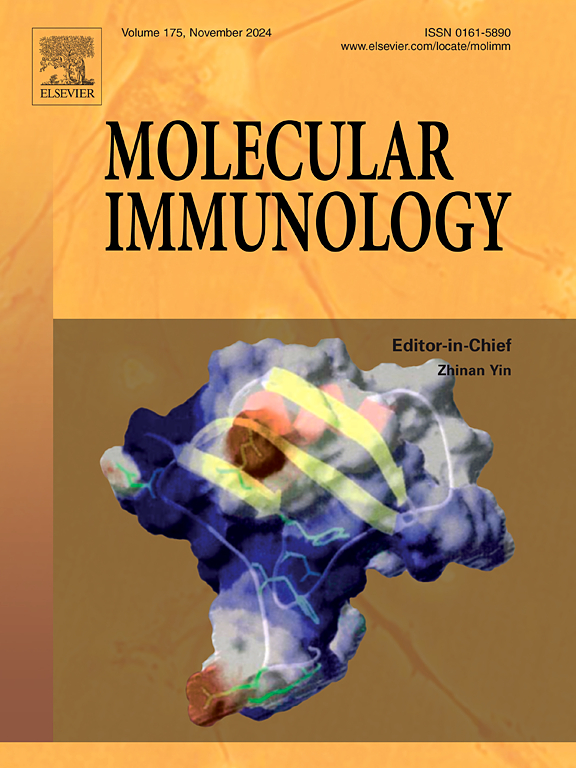截断的IFI16 mRNA转录物可以控制其病毒DNA防御活性
IF 3
3区 医学
Q2 BIOCHEMISTRY & MOLECULAR BIOLOGY
引用次数: 0
摘要
最著名的一种名为ALRs的病毒受体是IFI16(干扰素诱导蛋白16),它负责对病毒dsDNA的反应。一个pyrin结构域(PYD)、两个HIN结构域、一个NLS(核定位序列)和S/T/P重复区构成了IFI16的结构。已经描述了5个替代转录本(V1, V2, V9, V4和Vβ),它们编码具有不同结构,定位和功能的5种异构体(IFI16-iso1, 2, 3, 4和β)。另外4个转录本(V3, V5, V6和V8)和12个预测转录本(VX1-VX7, VX1.1-VX5.1)也在没有任何结构研究的情况下登记在基因库中。在本研究中,我们对健康人群中IFI16转录本的存在进行了完整的研究。除了6个所谓的预测转录本外,发现了所有描述的备选转录本,并描述了2个新的转录本(V10, V11)。IFI16表达调控mRNA的主要机制是由于非编码区域的插入和几乎所有外显子的丢失。共发现了9种不同的异构体,并构建了相应的蛋白质模型,以确定其功能的修饰以形成炎症小体或与病毒DNA的结合。本文章由计算机程序翻译,如有差异,请以英文原文为准。
Truncated IFI16 mRNA transcripts can control its viral DNA defense activity
One of the most well-known viral receptors of the group called named ALRs is IFI16 (interferon-inducible protein 16) that are responsible for responses against viral dsDNA. A pyrin domain (PYD), two HIN domains, a NLS (nuclear localization sequence), and S/T/P repeats region form the structure of IFI16. Five alternatively transcripts have been described (V1, V2, V9, V4 and Vβ) that encode five isoforms (IFI16-iso1, 2, 3, 4 and β) with different structure, localization, and function. Another four transcripts (V3, V5, V6, and V8) and 12 predicted transcripts (VX1-VX7, VX1.1-VX5.1) have also been registered in the Genebank without any structural study. In the present study, we have performed a complete study of the presence of the IFI16 transcripts in a healthy population. All the alternative transcripts described except six of the so-called predicted transcripts were found, furthermore, two new transcripts (V10, V11) were described. The main mechanisms for the regulation of mRNA from IFI16 expression are due to the insertion of non-coding regions and the loss of almost all exons. A total of nine different isoforms were found and the corresponding protein models were constructed to establish the modification of its functionality to form inflammasomes or the binding to viral DNA.
求助全文
通过发布文献求助,成功后即可免费获取论文全文。
去求助
来源期刊

Molecular immunology
医学-免疫学
CiteScore
6.90
自引率
2.80%
发文量
324
审稿时长
50 days
期刊介绍:
Molecular Immunology publishes original articles, reviews and commentaries on all areas of immunology, with a particular focus on description of cellular, biochemical or genetic mechanisms underlying immunological phenomena. Studies on all model organisms, from invertebrates to humans, are suitable. Examples include, but are not restricted to:
Infection, autoimmunity, transplantation, immunodeficiencies, inflammation and tumor immunology
Mechanisms of induction, regulation and termination of innate and adaptive immunity
Intercellular communication, cooperation and regulation
Intracellular mechanisms of immunity (endocytosis, protein trafficking, pathogen recognition, antigen presentation, etc)
Mechanisms of action of the cells and molecules of the immune system
Structural analysis
Development of the immune system
Comparative immunology and evolution of the immune system
"Omics" studies and bioinformatics
Vaccines, biotechnology and therapeutic manipulation of the immune system (therapeutic antibodies, cytokines, cellular therapies, etc)
Technical developments.
 求助内容:
求助内容: 应助结果提醒方式:
应助结果提醒方式:


